Exploring Granite Quarries in South Africa: A Comprehensive Guide
Exploring Granite Quarries in South Africa: A Comprehensive Guide
Blog Article
Uncovering the Rich Background and Sustainable Practices of Granite Quarrying
As we stand on the precipice of discovering the complex tapestry of granite quarrying, a journey via time exposes not just the physical act of drawing out stone but likewise the social and historic importance woven right into the really fabric of this practice. From the old beginnings that laid the foundation for modern-day quarrying methods to the sustainable methods that are shaping the future of this market, each chisel mark on granite surface areas narrates waiting to be unearthed (granite quarries in south africa). The legacy of granite quarrying extends much past simple removal; it is a testament to human ingenuity, strength, and the long-lasting appeal of this stunning stone
Ancient Beginnings of Granite Quarrying
Going back to old human beings, the practice of quarrying granite has actually been an indispensable part of human background and building advancement. The earliest proof of granite quarrying days back to old Egypt, where huge pyramids and elaborate sculptures were crafted from this long lasting rock. The Egyptians made use of primitive devices to extract granite blocks from quarries, showcasing the significance of this material in their monumental building and constructions.
Relocating onward in background, the Greeks likewise made substantial contributions to the quarrying of granite. The Greeks used granite in different architectural wonders, such as temples and statues, showing their ability in shaping and carving this sturdy rock. The Romans further fine-tuned the techniques of quarrying granite, employing innovative tools like chisels and hammers to essence and form granite for their legendary structures.
With the centuries, the method of quarrying granite has actually developed, with contemporary innovations boosting efficiency while preserving the classic allure of this natural stone - granite quarries in south africa. From ancient people to contemporary building contractors, the tradition of granite quarrying proceeds to form our world
Evolution of Quarrying Methods
The evolution of quarrying techniques has been noted by a continuous development in the direction of greater efficiency and accuracy in drawing out granite. Early quarrying techniques included hand-operated labor with fundamental tools such as blades, hammers, and wedges to draw out granite blocks from the planet.
In more current times, the development of equipment reinvented the quarrying industry, enabling much faster removal prices and increased performance. Technologies such as diamond cable saws, high-pressure water jets, and pneumatically-driven drills have ended up being conventional in modern quarries, allowing for accurate cutting and reduced waste. Additionally, developments in computer-controlled tools and 3D modeling have actually optimized quarrying operations, causing minimal environmental impact and improved sustainability methods. As the need for granite continues to climb, the advancement of quarrying strategies continues to be indispensable to Continue conference market requires efficiently and sustainably.
Social Relevance of Granite
Granite holds a profound social significance across various civilizations due to its long-lasting visibility in building masterpieces and click site respected monoliths. The cultural significance of granite extends beyond its physical qualities; it personifies resilience, security, and timelessness, making it a symbol of withstanding heritages and traditions.

Sustainable Practices in Quarrying
Among the abundant background of granite quarrying and its social importance lies a growing emphasis on lasting methods within the market. As environmental awareness and worries about source exhaustion have actually enhanced around the world, the quarrying industry has progressively embraced lasting methods to reduce its effect on the atmosphere and surrounding communities.

Additionally, reclamation and rehab of quarry websites post-extraction are important to sustainable techniques. By restoring quarried locations to an all-natural or valuable state, such as creating wildlife habitats or recreational areas, quarriers can balance out the ecological footprint of their operations and add positively to the neighborhood ecosystem.
Tradition of Granite Quarrying
With a historic backdrop soaked in workmanship and commercial development, what sustaining impact has granite quarrying left on the landscape of modern-day society? The legacy of granite quarrying transcends mere removal methods; it has formed building marvels, city landscapes, and cultural heritage worldwide. The sturdy nature of granite has made it a preferred choice for monuments, structures, and infrastructure, standing as a testimony to the ability and creativity of quarry workers across generations.
In addition, the financial footprint of granite quarrying can not be neglected. The market continues to supply job opportunity and drive regional economic situations in areas where granite removal prevails. It has actually likewise spurred technical innovations in quarrying methods and equipment, causing a lot more reliable and sustainable practices.
In regards to sustainability, the legacy of granite quarrying includes initiatives to mitigate ecological impacts through recovery projects and responsible resource administration. By balancing economic interests with ecological stewardship, the market makes every effort to make certain that future generations can proceed to take advantage of this long-lasting natural deposit.
Conclusion

Report this page